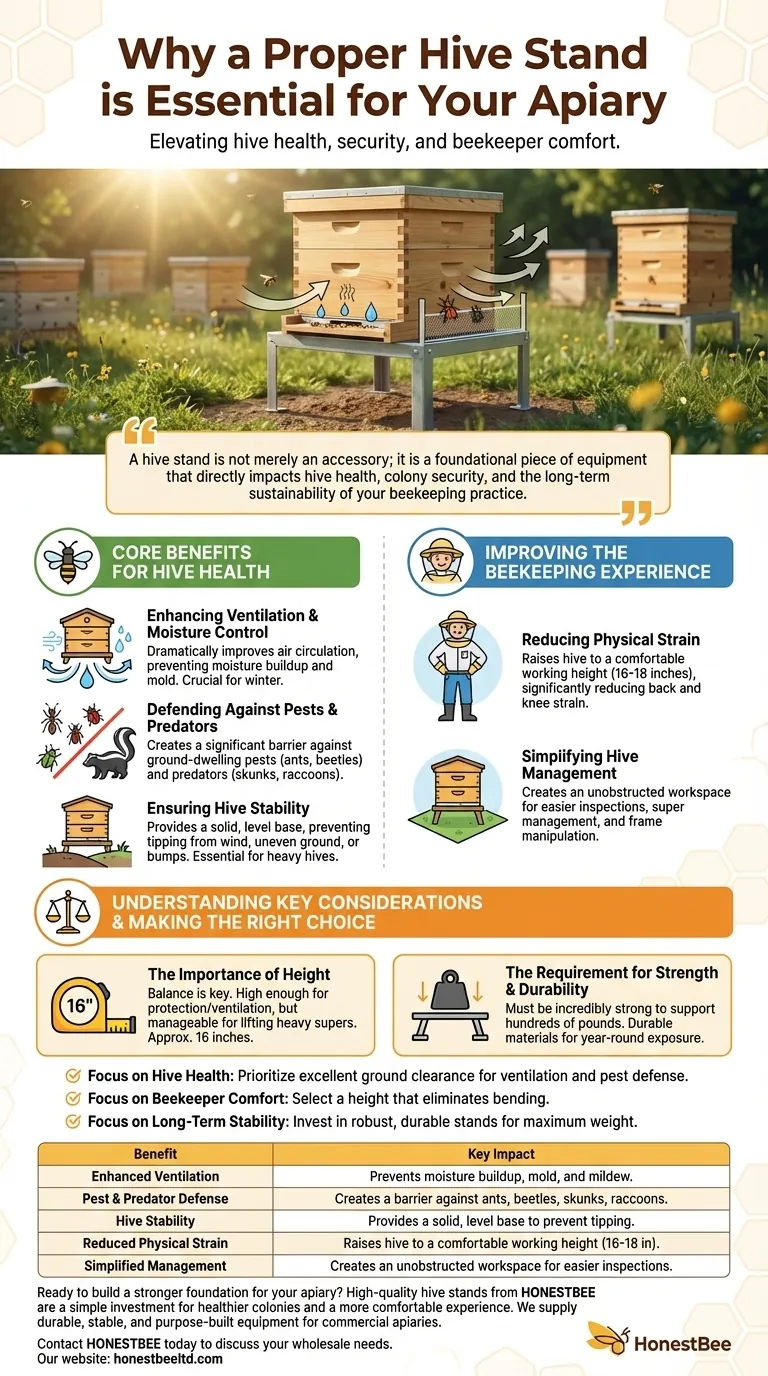The primary benefits of a proper hive stand are elevating the hive for better ventilation and pest protection, providing a stable and level foundation, and raising the hive to a height that significantly reduces back strain for the beekeeper. A good stand makes routine hive management more effective, secure, and physically manageable.
A hive stand is not merely an accessory; it is a foundational piece of equipment that directly impacts hive health, colony security, and the long-term sustainability of your beekeeping practice.

Core Benefits for Hive Health
A hive stand’s most critical function is to create a healthier and more secure environment for your bees. Lifting the colony off the ground addresses several key environmental challenges.
Enhancing Ventilation and Moisture Control
Lifting a hive even a few inches off the damp ground dramatically improves air circulation beneath the hive.
This ventilation is crucial for preventing moisture buildup inside the hive, especially during winter, which helps the colony regulate temperature and avoid mold and mildew.
Defending Against Pests and Predators
Elevation creates a significant barrier against ground-dwelling pests. It makes it much more difficult for ants, slugs, and small hive beetles to gain access.
A stand also offers protection from predators like skunks or raccoons, which may otherwise disturb or attack the hive entrance.
Ensuring Hive Stability
A proper hive stand provides a solid, level base that is essential for hive stability. This prevents the hive from tipping over due to uneven ground, strong winds, or accidental bumps.
Given that a mature hive full of honey can weigh hundreds of pounds, this stability is non-negotiable for the safety of the colony.
Improving the Beekeeping Experience
Beyond benefits for the bees, a well-chosen hive stand makes the physical work of beekeeping far more enjoyable and sustainable for the beekeeper.
Reducing Physical Strain
This is perhaps the most immediate benefit for the beekeeper. A stand raises the hive to a comfortable working height, typically 16 to 18 inches.
This elevation minimizes the need to bend over or kneel during inspections, dramatically reducing strain on your back and knees. This makes hive management less of a chore and more of a pleasure.
Simplifying Hive Management
A stand creates a clear, unobstructed workspace around the entire hive. This makes it easier to perform inspections, add or remove supers, and manage other tasks without tripping over vegetation.
The stability it provides also ensures that you can manipulate frames and hive bodies with confidence, knowing the structure is secure.
Understanding the Key Considerations
Not all stands are created equal. The effectiveness of a hive stand depends entirely on its design and construction, focusing on two key attributes mentioned in the references: strength and height.
The Importance of Height
The height of your stand is a balance. It must be high enough to provide adequate pest protection and ventilation.
However, it should not be so high that lifting heavy, honey-filled supers onto the top of the hive becomes difficult or dangerous. A height of around 16 inches is a common and effective compromise.
The Requirement for Strength and Durability
A hive stand must be incredibly strong and stable. It has to support the immense weight of a mature colony without any risk of wobbling or collapsing.
Choose materials that are durable and can withstand year-round exposure to the elements. Simple, sturdy designs are almost always superior to complex, flimsy ones.
Making the Right Choice for Your Apiary
The ideal hive stand supports the health of your bees and your body simultaneously.
- If your primary focus is hive health: Prioritize a stand that provides excellent ground clearance for ventilation and defense against local pests.
- If your primary focus is beekeeper comfort: Select a stand that raises the hive to a height that eliminates bending and makes inspections physically effortless.
- If your primary focus is long-term stability: Invest in a robust, level stand made from durable materials that can reliably support the maximum weight of your hive in any weather.
Ultimately, a good hive stand is a simple investment that provides a secure foundation for successful beekeeping.
Summary Table:
| Benefit | Key Impact |
|---|---|
| Enhanced Ventilation | Prevents moisture buildup, mold, and mildew. |
| Pest & Predator Defense | Creates a barrier against ants, beetles, skunks, and raccoons. |
| Hive Stability | Provides a solid, level base to prevent tipping. |
| Reduced Physical Strain | Raises hive to a comfortable working height (16-18 inches). |
| Simplified Management | Creates an unobstructed workspace for easier inspections. |
Ready to build a stronger foundation for your apiary? A high-quality hive stand from HONESTBEE is a simple investment that pays off in healthier colonies and a more comfortable beekeeping experience. We supply durable, stable, and purpose-built beekeeping equipment designed for the demands of commercial apiaries and distributors.
Contact HONESTBEE today to discuss your wholesale needs and discover how our hive stands can support your success.
Visual Guide

Related Products
- Plastic Bee Hive Stand for Beekeeping
- Professional Engraved Round Hive Number Tags for Beekeeping
- Metal Bee Hive Stand Bee Box Stand for Beekeeping
- Metal Hive Feet Bee Hive Stand for Ant Protection
- Wholesales Dadant Size Wooden Bee Hives for Beekeeping
People Also Ask
- How do bees regulate the temperature of their hive during the summer? Discover Their Natural Cooling System
- How do plastic bee hives compare to wooden hives in handling? Reduce Strain & Boost Efficiency
- What is the purpose of a hive stand in a Langstroth hive? Protect Your Hive and Boost Colony Health
- What are the main differences between Langstroth and Top Bar Hive designs? Choose the Right Hive for Your Beekeeping Goals
- What are the advantages of a second hive if the queen is killed? The Ultimate Insurance Policy for Your Apiary



















